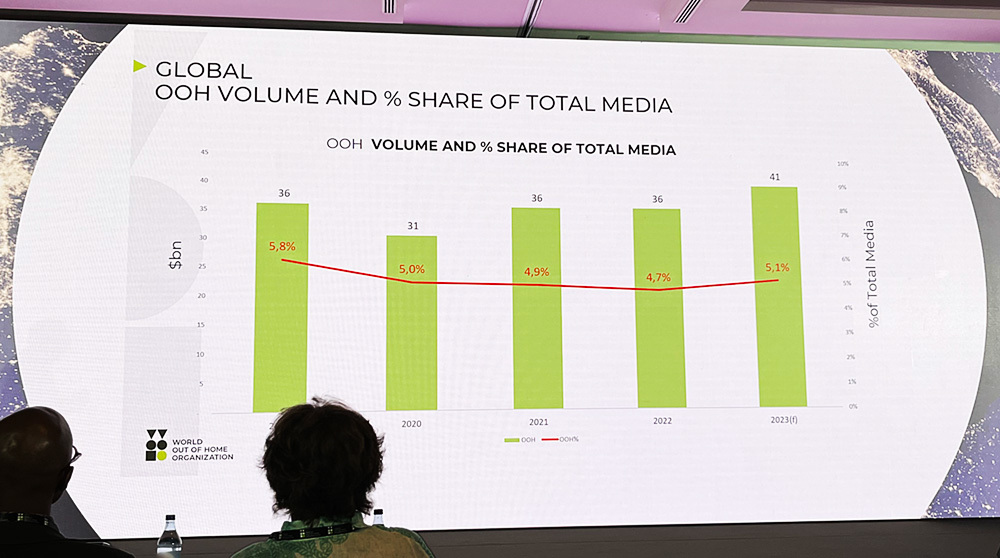Note: This website was automatically translated, so some terms or nuances may not be completely accurate.
OOH from a Global Trend Perspective
The COVID-19 pandemic severely impacted the OOH (Out Of Home: outdoor and transit advertising) industry as people reduced outings and traffic volumes declined.
However, as the pandemic subsided, the OOH market began to recover. In 2022, the global OOH market showed a full recovery, with DOOH (Digital Out Of Home: advertising using digital signage) experiencing particularly strong growth. In Japan, a recovery is anticipated in 2023 as movement restrictions are lifted.
This series will primarily provide the latest OOH trends, focusing on DX, to corporate marketing and advertising professionals, as well as those engaged in OOH operations.
Global OOH sales in 2022 reached an all-time high
WOO (World Out Of Home Organization) is an international association comprising OOH industry groups and media companies from around the world. It holds annual international conferences and regional meetings to address industry challenges and drive further development.

At the 2022 international conference, WOO President TOM GODDARD announced, "OOH media sales in 2022 surpassed pre-pandemic 2019 levels, setting a new record high. Since then, the industry is projected to grow at a CAGR (Compound Annual Growth Rate) of 4%."
This growth is expected to be driven by increased revenue from DOOH while maintaining income from static media like analog signage.
However, while OOH sales are increasing, a key challenge is that OOH's share of total media advertising budgets struggles to exceed 5%, a phenomenon referred to as the "5% syndrome." "Aiming for 10%" is a common goal across the global OOH market, and countries exceeding 10% are seen as models to learn from worldwide.

Three Key Elements to Achieve a 10% OOH Share of Total Media Advertising Budget
How can we raise OOH's share of total media advertising budgets to 10%? While various ideas were discussed at the WOO conference, the following three factors appear particularly crucial.
First is investment in DOOH in collaboration with cities and municipalities. While Asian countries face distinct challenges in selling OOH due to differences in language, culture, national size, and economic maturity, a common thread was viewing DOOH as a growth driver and promoting DOOH as a hardware solution. Incidentally, DOOH is more developed in these countries than in Japan.
Second is enabling integrated planning of OOH alongside TV and digital. This requires standardizing audience measurement—the process of quantifying the number of individuals estimated to be within the screen's visible area and exposed to the OOH ad.
WOO published updated Audience Measurement Guidelines at its 2022 international conference, covering DOOH, the use of the latest audience data, and cross-media measurement. In Japan, a translated version was released by the Digital Signage Consortium in October 2022.
Although DOOH media is increasing, it is often ordered alongside analog signage. To measure advertising exposure across different media formats, standardizing OOH exposure measurement specifications as much as possible makes purchasing easier.
Therefore, the Measurement Guidelines introduce initiatives from various countries as case studies and provide insights for creating unified metrics within one's own country. Establishing unified metrics will likely advance the automation of OOH business processes, such as planning, sales, and effectiveness verification, which have garnered significant attention in recent years. We plan to cover the Measurement Guidelines in this series as well.
Third is the integration of the OOH industry. It was stated that co-creation within the industry, rather than competition, leads to development. Consequently, the role of each country's National Association (the OOH association representing the nation) becomes significant, requiring practical functions beyond lobbying stakeholders, such as designing and providing audience measurement. A panel discussion involving OOH associations from five countries highlighted their energetic efforts to tackle OOH challenges specific to their respective nations. WOO promotes co-creation among location owners, advertising agencies, tech partners, and others involved in OOH, serving as a platform for sharing best practices across countries.
Overseas, audience measurement and delivery system integration are advancing
Countries with fewer OOH industry players tend to have oligopolistic markets where associations function effectively and where audience measurement and delivery systems are easier to establish. In these countries, OOH accounts for 7-8% of total media advertising budgets. Here are some notable country examples.
Germany's Ströer is a unique advertising company offering services that combine not only OOH media but also digital media and e-commerce. It covers 70% of the domestic reach through indoor and outdoor video media.
With over 7,000 DOOH units installed at major German stations, roads, shopping centers, and subway/suburban railway platforms, it offers the highest digital reach in Germany's public spaces. Committed to technological innovation, its programmatic OOH (*) ratio stands at 18%.
In Australia, the outdoor advertising media company oOh! Media owns media reaching 77% of people in urban and regional areas, holding a 40% inventory share. Its DOOH ratio is exceptionally high at 60%.
Turning to Asia, Singapore has a consolidated OOH player landscape with a 50% DOOH ratio. Stellar Ace is Singapore's rail media company and an advertising agency offering integrated on/off proposals. It possesses advanced marketing capabilities, including media planning that captures the customer journey and programmatic OOH for optimized ad delivery to targets.
Japan ranks third globally in OOH market size. There are over 1,000 outdoor advertising media companies, with four railway advertising companies covering 78% of the market. Unlike the previously mentioned countries where outdoor and railway media were owned by the same companies, Japan's market is characterized by separate entities and a large number of players. The DOOH ratio is 14.5%, and the programmatic OOH ratio is 6%. Currently, the OOH industry is promoting collaboration, and these ratios are expected to increase in the future.
*Programmatic OOH: Enables networked DOOH (Digital Out Of Home: advertising using digital signage), facilitating flexible transactions and delivery while allowing centralized management of ad slots, metrics, and distribution.
Sustainability is also a key factor in OOH's development
The 2023 WOO session also touched on various sustainability initiatives. As advertisers work to reduce CO2 emissions in their production activities, marketing efforts will increasingly require climate-conscious approaches. While DOOH is already a low-emission medium due to technological advancements like LED, it was noted that communicating this message will become essential going forward.

The OOH market is projected to grow steadily, driven by increased DOOH revenue. Achieving this requires expanding DOOH, enabling integrated media planning to make it easier to buy, establishing audience measurement for effectiveness tracking, and fostering collaboration among media owners, agencies, and tech partners. Case studies from Germany and Australia serve as benchmarks.
Starting next time, we plan to introduce methods for evaluating creative campaigns that generated buzz using OOH media, along with research findings. This includes social listening as an evaluation method, programmatic OOH planning case studies, measurement guidelines, and other aspects of OOH media's appeal.
Was this article helpful?
Newsletter registration is here
We select and publish important news every day
For inquiries about this article
Author

Kana Misawa
Dentsu Inc.
Out-of-Home Media Division
After working in creative, sports business, AI chatbot, and healthcare business development, he assumed his current position. He is involved in developing media planning tools centered on OOH and business development in the data and technology domain. Ph.D. (Interdisciplinary Information Studies)


